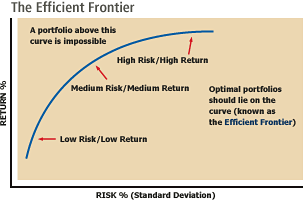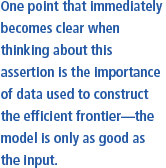

The Case for Active vs. Passive Management
For decades individuals have turned to financial advisors to construct diversified portfolios for their investments which have largely been based on the diversification principles of Modern Portfolio Theory as outlined in Harry Markowitz's famous 1952 Nobel Prize winning paper. The basic premise is that there is an optimum way to create a portfolio given an individual's appetite for risk. In other words, for each level of risk there is an optimal mix of asset classes that will maximize a portfolio's return over time. When this risk/return relationship is graphed it forms a line that is known as the "Efficient Frontier" (see Graph below).

What is Passive Asset Allocation?
Markowitz's Efficient Frontier is based on the belief that it is difficult, if not impossible to out-perform the market on a consistent basis. As a result the majority of investment advisors construct portfolios via a passive asset allocation model. These portfolios are static, infrequently monitored, and are often subject to much greater risk than anticipated given the fact that the historical data used to create these models has fundamentally changed and thus generates calculations that we believe to be flawed.
Regardless of stock market behavior, a passively managed portfolio is only changed during periodic rebalancing, the primary purpose of which is to return the portfolio to its original allocation.
Our proprietary research, and a joint research effort with the Darden Graduate
School of Business at the University of Virginia, strongly suggests that the Efficient Frontier
 is both outdated and broken. Nothing provides greater evidence of this fact than what has happened to passively managed "diversified"
portfolios over the past few years.
is both outdated and broken. Nothing provides greater evidence of this fact than what has happened to passively managed "diversified"
portfolios over the past few years.
